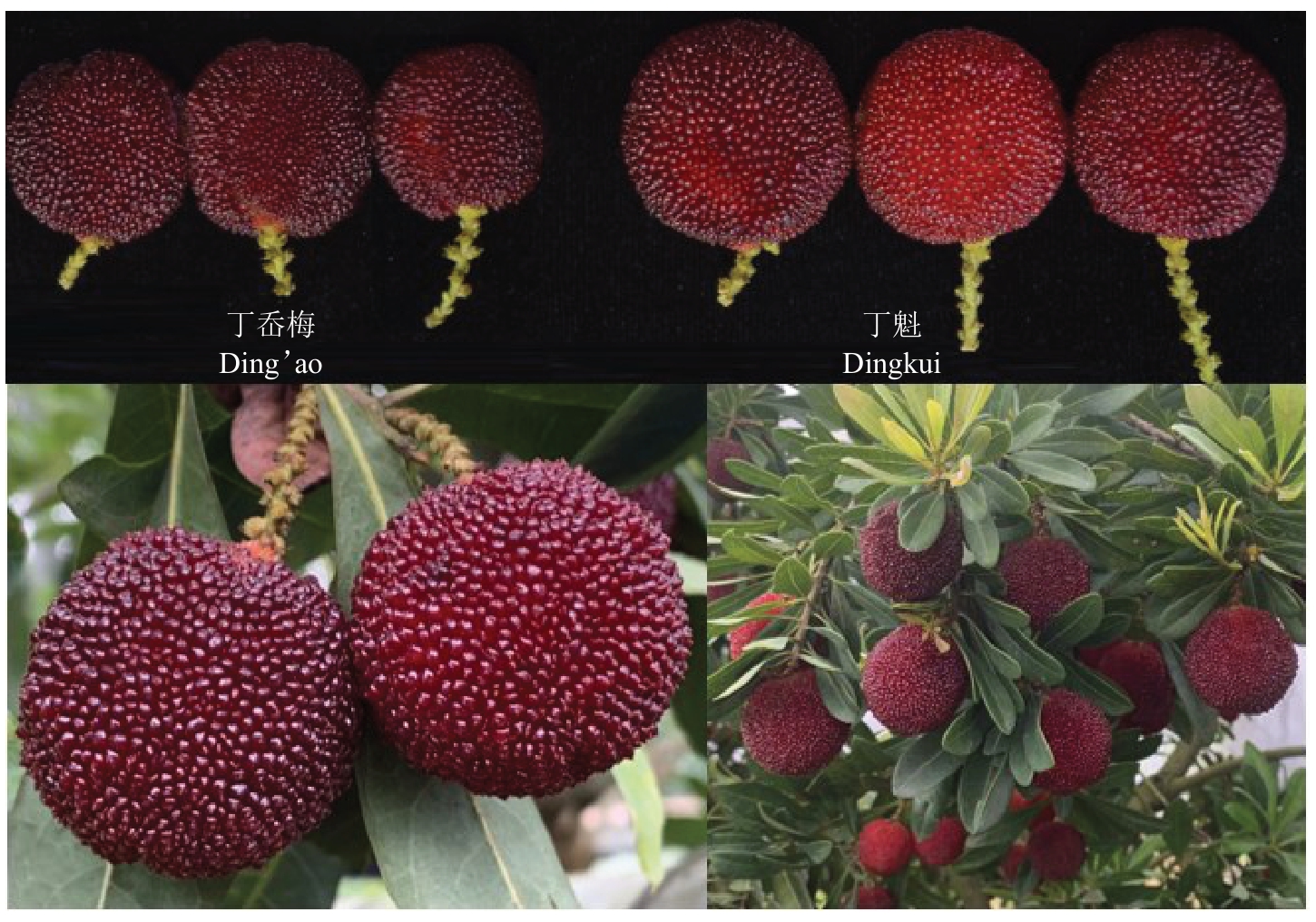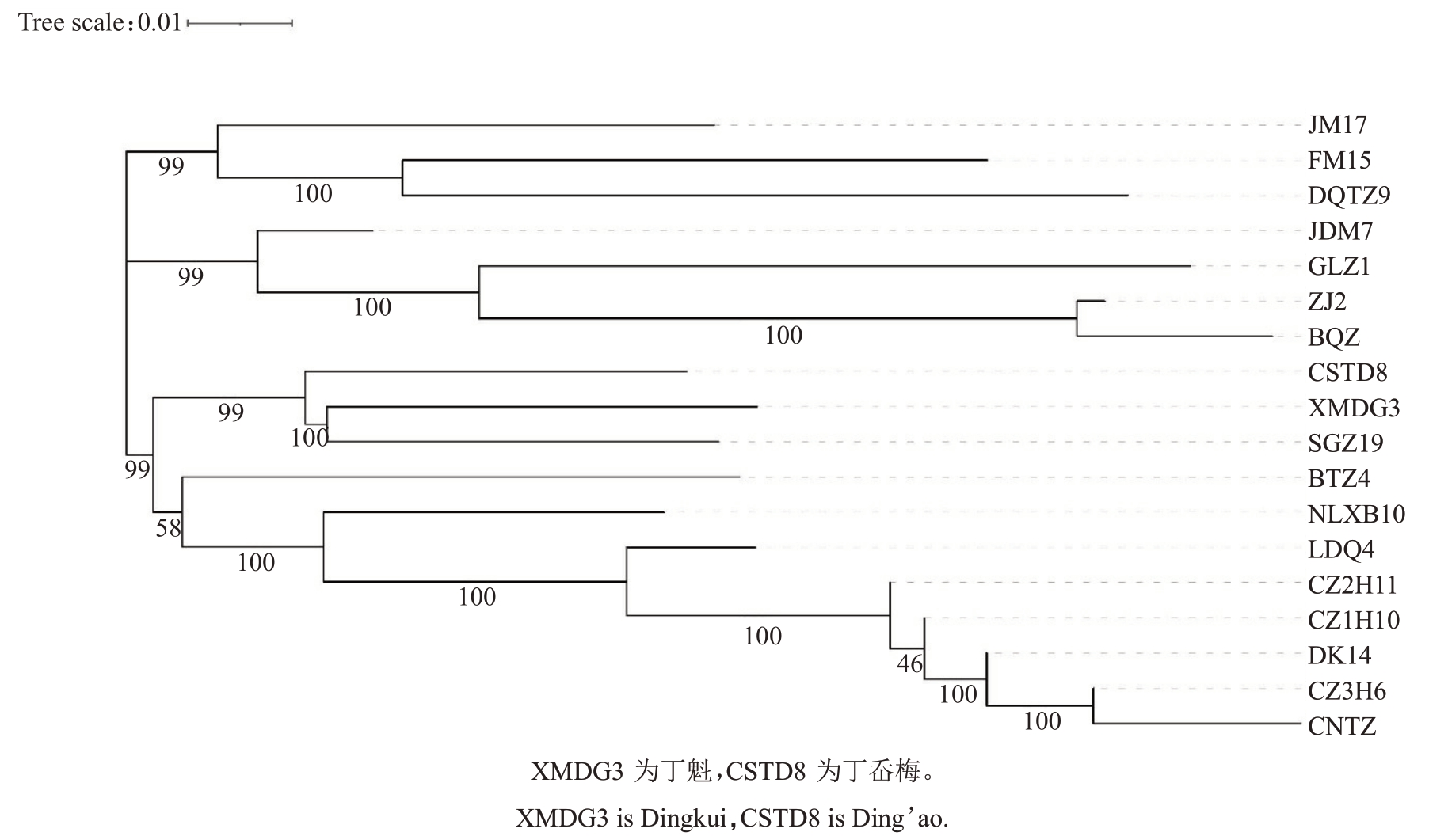杨梅(Myrica rubar Sieb. et Zucc.)属杨梅科(Myricaceae)杨梅属(Myrica Lour.)常绿果树[1],果实初夏成熟,不仅颜色鲜艳,风味独特,还富含杨梅苷、花青苷、黄酮、维生素C、氨基酸等功能性物质,是我国长江以南地区重要的经济作物[2-3]。随着居民消费水平的提升,大果型、风味浓、耐贮藏的精品杨梅备受青睐。目前市场主栽优良品种大多数为中熟或晚熟品种[4],早熟品种往往因果型小、风味淡而逐渐退出市场。一些果农为了追求大果型杨梅,投入大量人力、财力进行疏花疏果,经常出现丰产不丰收的现象,不利于杨梅产业健康持续发展。为此,浙江省亚热带作物研究所果树团队以易管理、大果型、风味浓和耐贮藏等为育种目标,开展了杨梅新品种选育工作。2003年在温州市瓯海区茶山街道丁岙梅果园发现1株果型大、挂果适中、风味浓的变异株。经过多年、多点对其植物学特征、生物学性状及果实品质进行观察评价,发现该品种性状表现稳定、一致,经分子鉴定,该品种与其他品种不存在同物异名现象。于2024年12月获浙江省林业局林木良种认定(认定号:浙R-SV-MR-006-2024),品种定名为丁魁(图1)

图1 杨梅新品种丁魁
Fig.1 A new bayberry cultivar Dingkui
1 选育过程
丁魁杨梅是2003 年在温州市瓯海区茶山街道新民村丁岙梅果园中发现的大果型早熟优良变异单株。分别于2009 年、2016 年进行高接繁殖,经过20多年对母树和无性繁殖后代进行植物学、生物学和果实经济性状的观察与鉴定,发现果实性状表型稳定、一致。
2 主要性状
2.1 果实主要经济性状
丁魁杨梅果实颜色均匀,呈紫红色,果型大,果梗中等长度,果实近圆球形,肉柱圆润,质地脆嫩多汁,风味浓,果实耐贮性好。果实平均单果质量22.6 g,是丁岙梅的2.19 倍,果形指数0.97,可食率95.6%,果实硬度2.89 N,可溶性固形物含量(w,后同)为10.8%,可滴定酸含量为10.57 g·kg-1,总糖含量为73.3 mg·g-1,黄酮类含量为0.74 mg·g-1,总酚含量为1.77 mg·g-1,氨基酸含量为7.76 mg·100 g-1,维生素C含量为33.3 mg·100 g-1(表1)。
表1 丁魁与丁岙梅果实性状比较
Table 1 Comparison of fruit attributes between Dingkui and Ding’ao bayberry

品种Cultivar成熟期Mature period可食率Edible ratio/%果实硬度Hardness/N丁魁Dingkui丁岙梅Ding’ao 6月2日June 2th 5月30日May 30th单果质量Single fruit mass/g 22.6±1.08 10.3±0.66果形指数Fruit shape index 0.97±0.02 0.98±0.03 95.6±0.51 93.2±0.46 2.89±0.10 2.79±0.12 w(可溶性固形物)Solid soluble content/%10.8±1.00 11.9±0.47 b(可滴定酸)Titratable acid content/(g·kg-1)10.57±0.57 11.93±0.14 w(总糖)Total sugar content/(mg·g-1)73.27±1.77 83.80±0.33 w(黄酮类)Flavone content/(mg·g-1)0.74±0.03 1.03±0.03 w(总酚)Polyphenol content/(mg·g-1)1.77±0.01 1.90±0.05 w(氨基酸)Amino acid/(mg·100 g-1)7.76±0.25 12.84±0.38 w(维生素C)Vitamin C content/(mg·100 g-1)33.26±1.19 31.28±0.88
2.2 植物学特征
丁魁杨梅树势强,冠幅大,圆头形或半圆形;叶片较大,呈倒披针状,深绿色,长11.1 cm、宽2.7 cm,叶柄较短;雌花花序圆筒状,长0.76 cm、粗0.31 cm,花朵的形状为“V”字形。
2.3 生物学特性
丁魁花芽的萌动期在2 月下旬,初花期在3 月初,盛花期在3 月上旬,终花期、幼果期在3 月中下旬。春梢抽生期4月中旬,夏梢抽生期6月中下旬,果实始熟期为6月初,果实发育期55~60 d。抗肉葱病能力强于丁岙梅。
2.4 生长结果习性
以春、夏梢短果枝的顶端花芽结果为主,自然坐果率约为15%,明显低于丁岙梅,挂果率适中,定果时人工疏果量小,易于管理。果实成熟期较为一致,结果分布均匀,大小年结果现象不明显。该品种对土壤要求不严格,适宜在山地、丘陵地种植;适应范围广,丰产,稳产。一般高接后5~7 a(年)即进入稳产期,产量较为稳定,平均666.7 m2产量可达660 kg。
2.5 分子标记鉴定
采用SNP 分子标记技术[5]对2023 年采集的18份杨梅样品进行分子鉴定。18 份杨梅资源遗传相似系数(GS)的变化范围为0.68~0.97。聚类分析将18份杨梅材料分为两大类,第1类包含东魁(DK14)杨梅等5 份材料,其中苍南2 号(CZ2H11)和DK14遗传相似系数最大为0.97。第2 类包含13 份样品,丁魁(XMDG3)与其他各样品之间的遗传相似系数变化范围在0.69 和0.78 之间,与苍南土种(CNTZ)的遗传相似系数最小为0.69,与丁岙梅(CSTD8)的遗传相似系数最大为0.78。结果证实丁魁与其他品种不存在同物异名现象,从分子水平证明丁魁是一个杨梅新品种(图2)。

图2 杨梅品种丁魁与其他品种的遗传相似性聚类分析
Fig.2 A cluster dendrogram based on molecular markers of Dingkui and other arbutus cultivars
3 栽培技术要点
3.1 适栽区域
适宜在气候温润的浙南及气候相似的地区栽培。建议选择土质深厚、有机质含量丰富、水源充足、pH值4.5~6.5之间的砂砾性红黄壤土建园种植,果园管理采取自然生草方式。
3.2 种植技术
育苗以嫁接繁殖为主。于每年3—4月,选择根径粗度0.8~1.0 cm 的杨梅实生苗作为砧木,采用枝接法进行嫁接;嫁接后15~20 d,检查嫁接成活率,同时做好嫁接苗解绑、剪砧、除萌、摘心、水肥管理和病虫防治等工作。根据省力化、宜机化建园要求,选用4 m×4 m 株行距、定植穴0.8 m×0.8 m×0.6 m 的矮化密植方式进行苗木定植和建园。对果园雄株配置模式没有特殊要求,与丁岙梅相同。
3.3 整形修剪
该品种以中短果枝结果为主。对于幼龄树,以培养开心形树形为主,选留3~4个生长健壮、分布均匀、角度合适(与主干夹角45°~60°)的枝条作为主枝,其余枝条去除。初结果树一般进行适当短截和疏剪,保留中庸、充实的结果母枝,疏除过密、细弱、交叉、重叠的枝条,还可以采用拉枝、压枝、吊枝、撑枝等方式减弱直立枝的顶端优势,让内膛充分通风透光,促进中短果枝花芽分化[6]。对盛果期树修剪,疏除树冠顶部和外围的直立、过密枝条,打开光路,改善内膛光照条件;回缩下垂、衰弱的主枝、侧枝,更新复壮树冠;对连续结果多年、生长衰弱的结果枝组进行回缩更新,剪去先端部分,刺激下部萌发新梢,形成新的结果枝;疏除衰老、枯死、病虫害严重的结果枝,保留健壮、充实的结果母枝。对衰老树进行重度修剪,一般在主枝、侧枝的中下部进行回缩,保留骨干枝长度的1/2~1/3,刺激萌发新梢,重新形成树冠;可以采用一次性更新或逐年更新的方法,一次性更新即在一年内对所有主枝、侧枝进行回缩;逐年更新则是每年更新1~2 个主枝,分几年完成树冠更新。结合树冠更新,对衰老树的根系进行更新,在树冠投影边缘处挖环状沟或放射状沟,切断部分老根,施入有机肥和新土,促进根系生长。
3.4 肥料管理
幼龄树定植前,在种植穴内施入足量的基肥。每穴施入腐熟的农家肥(如羊粪等)20~30 kg,同时加尿素或者复合肥1~2 kg,与土壤充分混合均匀。定植成活后,每年施肥3~4 次,分别在春梢、夏梢和秋梢萌芽前各施肥1次,以速效复合肥为主。
成年树以促进结果、提高产量和品质为主。按照增施有机肥和钾肥、控制氮肥、减少磷肥、重视中微量的施肥原则,以撒施、条施和加土覆盖为主。于每年秋季(9—10月)施基肥,基肥以有机肥为主,配合适量的化肥。分别于每年的3月、5月和7月施入花前肥、壮果肥和采后肥。
3.5 花果管理
该品种自然坐果率适中,无需人工疏果。如遇干旱天气,及时进行树冠喷水,保持空气湿度,有利于花粉传播和受精。花期如遇低温阴雨天气,需进行人工辅助授粉,提高坐果率。
3.6 病虫害等综合管理
该品种抗病、抗逆性强,挂果期无需喷施农药,只需加强常规性栽培管理,保持树冠合理的通风透光,重视冬季清园,增强树势,减少病虫害发生。果实采收后,割草覆盖,减少土壤水分散发,保湿抗旱。台风大雨天气过后应及时做好开沟排水工作,扶直树体,必要时进行少量修剪,促进根系恢复。
[1] 梁森苗. 杨梅栽培实用技术[M]. 北京:中国农业出版社,2019:2.LIANG Senmiao. Practical cultivation techniques of Chinese bayberry[M].Beijing:China Agriculture Press,2019:2.
[2] 胡子聪,雷琳,周晨光,蒋巧俊,苏凤贤,李彦坡,胡超凡.杨梅的营养功效及其应用研究进展[J]. 果树学报,2023,40(9):1966-1979.HU Zicong,LEI Lin,ZHOU Chenguang,JIANG Qiaojun,SU Fengxian,LI Yanpo,HU Chaofan. Research progress in nutritional benefit and application of Chinese bayberry fruit[J]. Journal of Fruit Science,2023,40(9):1966-1979.
[3] REN H Y,WANG H Y,YU Z P,ZHANG S W,QI X J,SUN L,WANG Z S,ZHANG M C,AHMED T,LI B. Effect of two kinds of fertilizers on growth and rhizosphere soil properties of bayberry with decline disease[J].Plants,2021,10(11):2386.
[4] 张跃建,缪松林. 我国杨梅品种资源及利用[J]. 中国南方果树,1999,28(4):24-25.ZHANG Yuejian,MIAO Songlin. Variety resources of red bayberry and their utilization in China[J].South China Fruits,1999,28(4):24-25.
[5] SONG Y,ZHAO Q,LIU D F,ZHANG P A,LI F Y,CHEN G J,LIU Y Y,XIA H T,GUO X Z. Genetic evolution analysis of Chinese bayberry germplasm resources in Southern Zhejiang with single nucleotide polymorphism (SNP) and insertion deletion(InDel)markers[J].Genetic Resources and Crop Evolution,2024,72:3265-3277.
[6] 郭秀珠,宋洋,刘冬峰,胡丹,陈巍.杨梅新品种早炭的选育[J].果树学报,2021,38(10):1821-1823.GUO Xiuzhu,SONG Yang,LIU Dongfeng,HU Dan,CHEN Wei. A new Chinese bayberry cultivar Zaotan[J]. Journal of Fruit Science,2021,38(10):1821-1823.